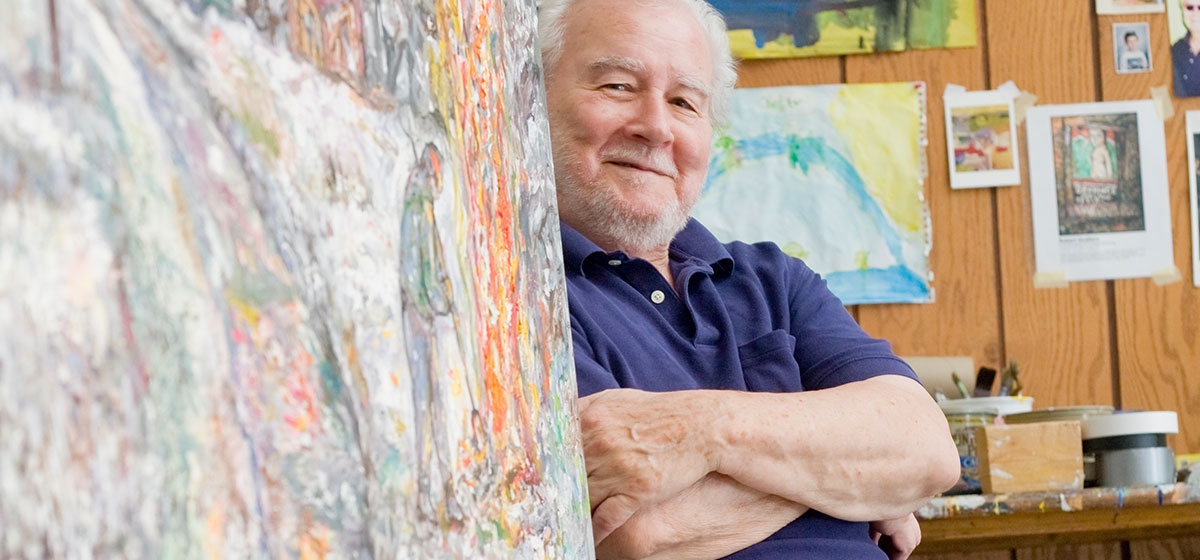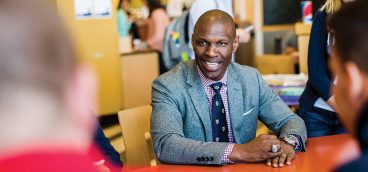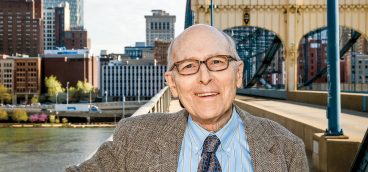
What’s it like to be 75? Well, I’ll tell you. I’ve had two knee replacements. I’ve had back surgery. I keep falling down and breaking things: my fingers, my skull.
But overall I feel pretty good, actually. I still like to work. I just keep on going. I find some way to continue.
My most recent show was autobiographical, my life story. It began with drawings I made at the age of about four, which my mother saved, and I did some paintings based on them. For one, I used an old, yellowed article from the McKeesport Daily News, the headline for which read: “Boy Explorer, 3, Falls Through Bridge.” That three-year-old was me! My picture was in the paper! A little friend and I had walked away from our houses and took a stroll through downtown McKeesport. I ended up slipping and falling about 15 feet through one of those street car trestles. Fortunately, I didn’t really get hurt.
It’s as true for painters as it is for any other creative people: We constantly mine our own lives and experience for material. I certainly have. But after a while, some of us get sick and tired of the me, me, me; the same portraits and the same stories, like coming home from school in the snow in Clairton and looking down at the mill. It’s what I’m known for, but still, it can get to you. “Pittsburgh: Hell with the lid off,” as we’ve heard so many times. That remark is often falsely attributed to Charles Dickens, but what the hell, right? It fits.
The Pittsburgh I grew up with doesn’t exist anymore. Things have changed a lot. I was born in 1934, right in the heart of the Great Depression. My mother was a schoolteacher and my father, when she married him, was just a laborer, working in the streets. Back in those days, if they found out you were married and a woman, you had to give up your job. The idea was, I imagine, that the man was supposed to be the breadwinner and the woman was better suited to tend to the home and kids. Because my father didn’t maintain “traditional” employment, we got to live off of two incomes, such as they were. Now, skip forward to 1952. I remember so clearly commuting from Clairton to Carnegie Tech, where I was an art student for a while. The next year, I volunteered to join the Army, mainly because the Korean War was winding down and I worried that we would not get the education benefits of the G.I. Bill once it was over. So I got in late, I played the system and played it well. And you might be surprised to hear me say this, but the Army was fun. They sent me to England as an artillery man. I didn’t have to do anything. “Join the Army, See the World,” indeed. I traveled all over the continent. Our base was about 90 minutes by train from London, so I spent many weekend in the city, which was terrific. When I got out of the service, I went back to Carnegie Tech for about another year, then went to California for a summer — and stayed for three years. I eventually graduated from a college out there.
So I spent 1956-59 in the Bay Area, and it was a magical time. One night, I saw the great Beat poet and City Lights publisher, Lawrence Ferlinghetti, standing in front of Mike’s Place in San Francisco. I once heard him read an autobiographical poem, part of which talked about leading a quiet life outside of Mike’s Place watching the world go by. I guess I was doing that, too. A lot of us were in those days. One morning, a friend burst into the studio and proclaimed, “We’re all beatniks.” That’s what we were, I suppose.
At the California College of Arts and Crafts, I became part of a what they called the Bay Area Figurative scene. After a while, however, California didn’t feel right to me. I used to wake up and think, “Damn, another beautiful day.” I couldn’t live in Berkeley. (Well, I did for three years but, finally, I just couldn’t.) So I came back east and hung around Shadyside for a bit, just being whatever Shadyside’s equivalent of a beatnik was.
When I got back here in 1959, the mills were still going strong. Industry was still the thing. But at the time, I wasn’t really interested in where I came from, which as McKeesport and Clairton. I was interested in painting, purely. So in the early 1960s, I went to teach at the State University of New York at Oswego, in upstate New York, which is a beautiful place. My wife Joanne is from there. Then I came back to Pittsburgh again in 1968 to teach at Pitt. I wanted to come back because I always felt that Pittsburgh was my place. But I needed to find something to paint. So I started painting what I saw and was criticized for it because, at that time, more hard-edged abstraction was in. I looked corny and gauche to some, I guess. But I just kept doing it, and gradually it became OK for me.
Well, I’ve been here ever since, which means that I also got to witness Pittsburgh’s transition from heavy industry to whatever we are now: this technological, service-based economy. For a while, what I painted—because that’s what I saw—were empty steel mills. That’s what was happening. The steel industry was imploding. And it was a good subject. But you can’t stay with it forever. So I stopped doing that 10 or more years ago.
In recent years, I’ve been trying new things in my work and it’s a little scary at times. No matter what anyone says, you don’t get automatic dispensation not to be afraid when you’re old. The difference is, you just do things anyway. I’m working on a new collection of paintings that incorporate mythological figures with the four seasons. I’m still very active, still painting a lot. I have no retirement plans. After all, what would I retire to? Lately, I’ve developed a bit of an obsession with butterflies. Where does that come from? Who knows? My other obsessions are rain and snow. You have to love weather if you live in Pittsburgh. I sometimes have to resist putting rain and snow in every painting.
So, given my advanced years and my presumed wisdom, how does one make a career of this thing called “art”? If you’re speaking of making a living, the answer is “with difficulty.” I’ve taught all over the place for many years in order to have time to paint, but I don’t have to do that anymore, fortunately. I have Social Security, of course, a little money put aside, and my work continues to sell fairly well.
But in art, the questions always are: “What’s new?” “Who’s hot today?” It’s true. And that should happen. New artists should take precedence. It’s a natural thing. And today’s artists seem to have a better grasp of how to make a go of it than did the artists of my generation. When you’re in college art school today, people talk about how to make a living. It was considered almost shameful to think that way when I was in art school.
I have an old friend who had been a creative head in advertising back in the day, and he told me once, “There’s no secret to selling your work. You just need to paint something that people want to buy.” And I did that for a while. It’s a wise move to do so—then go off and do what you want to do. I think there’s a way of splitting the difference and I believe I’ve done that. I’m still doing it. Small compromises: You learn to live with them.
As I’ve said, my most recent show was my life story. Before that was a show based on poetry. And I’ve had collaborations with other artists. But I’m not much involved with the social aspects of what’s going on now. Perhaps that’s part of being 75. I don’t give a damn about going to clubs, as I once did. It’s wonderful and natural for people younger than me to do that. Sure, I killed a few brain cells along the way, which was very important. That’s why you have so many of them to begin with. You know they’re going to get fried one by one—if you live life properly. I used to think I’d be dead before the end of the 1960s. But now I go over to my studio, work, then go home, go to the movies, go to art events, take some trips. That’s what life is like now for me, and my life is fine.






